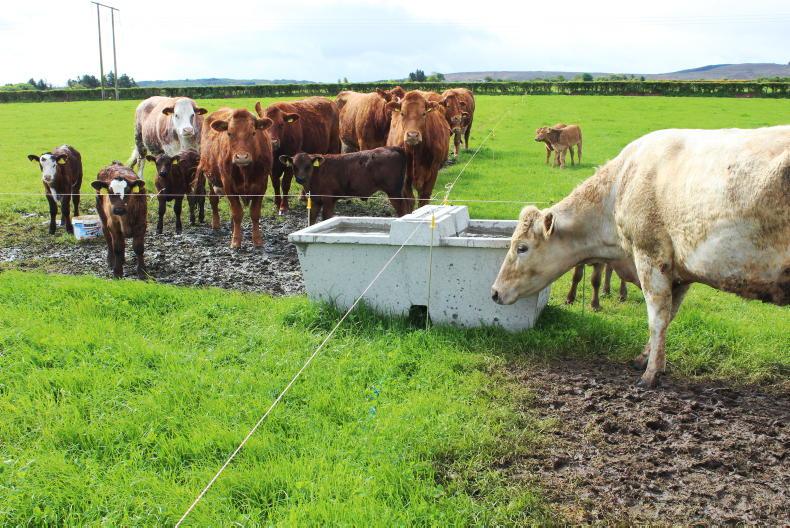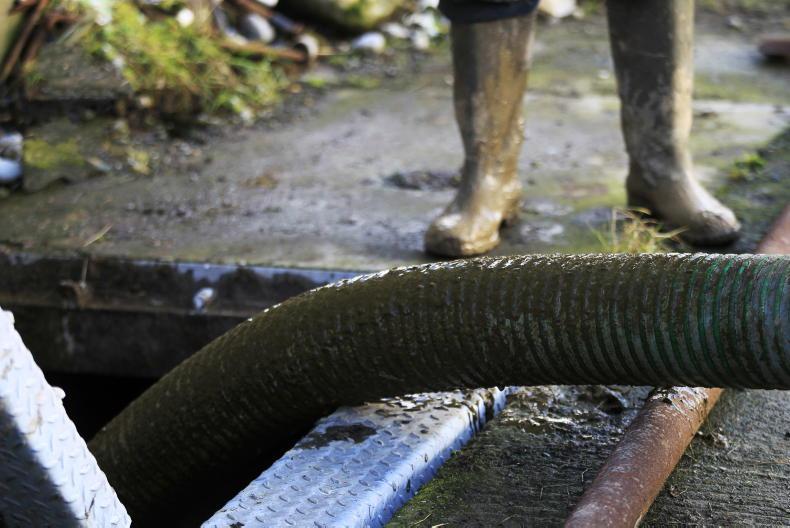Rotational grazing of livestock is the most efficient method of managing swards and cattle during the grazing season.
Regular handling of cattle as they move to fresh grass generally makes cattle more docile, which is a big advantage when working with livestock.
As swards get a rest period between each grazing, paddocks tend to yield more grass over the season.
In contrast, when swards are set-stocked, cattle will constantly look to graze the fresh regrowth, as this is more palatable than longer grass which has turned to stem.
Rotational grazing is the backbone of dairy farms utilising fresh grass, but beef and sheep farmers are also embracing the system.
For farmers thinking about setting up a rotational paddock system for the first time, outlined are 10 steps to help manage and bed in the new system.
1 Don’t be too ambitious when starting
When rotationally grazing animals for the first time, start off with a small area of the farm and just one or two grazing groups.
There is a learning process with rotational grazing – being able to gauge how much grass is in a paddock, how long a paddock will last a group of animals, whether the group can be increased and dealing with grazing in wet conditions takes time.
Also, as the season progresses, grass growth will change. A grazing surplus in June can run into a deficit in July.
Starting small and learning as you go increases the chances of making rotational paddocks work.
Trying to do too much in the first year increases the chance of cattle running out of grass and rotational grazing being abandoned.
Start with a block of 15 to 30 acres and focus on getting this area working properly. Once you are comfortable with managing this block, repeat on another part of the farm.
2 How many paddocks do I need?
Ideally, a good paddock setup should have a rotation length of around 18 to 21 days in late spring and summer. This means when cattle finish grazing a paddock, they should be re-entering the same paddock three weeks later.
When starting out, move cattle to fresh grass every third to fourth day. So assuming a 21-day rotation, approximately six to seven paddocks are required at the outset.
3 What size of paddocks do I need?
When starting out, don’t get too hung up on paddock size. It is better to have bigger paddocks that can be reduced in size or when grass growth starts to tail off.
Having paddocks that are too small means the rotation comes under pressure when grass growth is low and cattle have to be removed from the group.
As a rule of thumb, start with paddocks between two acres and three acres. The smaller paddock size applies to productive swards, whereas larger paddocks apply to older swards with slower regrowth.
4 Keep paddocks as square as possible
If fields are being divided using electric fencing, try to keep paddocks as square as possible. Cattle don’t tend to walk along the wire fence as much when paddocks are square compared with longer, narrower grazing divisions.
Providing water is always an issue when setting up rotational paddocks. Most fields are serviced by one drinking trough, which is usually placed in a corner of a field, making it awkward to split the field into smaller divisions.
When smaller paddocks are being split in two, set up plastic posts and wire so that it is tapering towards the water trough, rather than a diagonal split. Always graze the side furthest from the trough first.
In bigger fields with more than one grazing division, an extra water trough will be needed if the existing one cannot be moved.
As a low-cost option, place the new trough in an area that can service multiple paddocks. Roll the water pipe over ground to cut down on costs.
Laying the pipe over ground means it can be easily removed on rented land. Water should be turned off in winter to prevent the pipe from freezing.
6 Mains electricity or battery fencing
Ideally, mains electric fencing is the best option for setting up paddocks. But there are plenty of good battery fencers on the market.
Choosing a fencer with a solar cell extends the life of the battery and is cheaper over the season. Higher-voltage fencers are also worth the money.
Cattle should be moved to fresh grass every three or four days. Moving cattle will depend on the availability of grass and sometimes animals will need to be moved earlier than planned.
Do not let cattle run out of grass, especially during wet weather. Animals will become unsettled and more inclined to break fences.
There is no doubt that smaller paddocks can be a pain when it comes to spreading fertiliser. For the vast majority of farmers, it is not practical to dress a single two-acre paddock after every grazing. It is much more time-efficient to blanket-spread nitrogen across the full grazing block every three to four weeks.
9 Dealing with a grass surplus or deficit
There will come a point in May and June when grass growth surges ahead of demand and swards will get too strong for grazing.
As a beginner to rotational grazing, the idea of cutting surplus grass for bales can be daunting. Many farmers fear they will be short of grass in the next rotation.
But if cut on time and fertilised, paddocks will come back into the rotation after three weeks as normal.
When a surplus emerges, paddocks can be subdivided to allow more grass to be closed for silage. Alternatively, more cattle can be added to the group for a short period to increase demand.
During a grazing deficit, cattle will move around the rotation faster. Keep on top of fertiliser and either bring extra fields into the rotation or reduce the size of the grazing group.
In wet conditions, keep moving cattle to fresh grass even if this means moving every second day. It will help keep animals settled and reduce poaching on low-cover paddocks.
10 Walking the grazing block and monitor grass
The key with rotational grazing is to walk the paddocks once a week and monitor ground conditions and grass growth.
By walking swards weekly, you will be better informed on which fields need fertiliser, which fields are too soft to carry cattle and which fields can be skipped when there is surplus grass.
Read more
Watch back: Tullamore Farm suckler breeding webinar
Strong global beef trade
Rotational grazing of livestock is the most efficient method of managing swards and cattle during the grazing season.
Regular handling of cattle as they move to fresh grass generally makes cattle more docile, which is a big advantage when working with livestock.
As swards get a rest period between each grazing, paddocks tend to yield more grass over the season.
In contrast, when swards are set-stocked, cattle will constantly look to graze the fresh regrowth, as this is more palatable than longer grass which has turned to stem.
Rotational grazing is the backbone of dairy farms utilising fresh grass, but beef and sheep farmers are also embracing the system.
For farmers thinking about setting up a rotational paddock system for the first time, outlined are 10 steps to help manage and bed in the new system.
1 Don’t be too ambitious when starting
When rotationally grazing animals for the first time, start off with a small area of the farm and just one or two grazing groups.
There is a learning process with rotational grazing – being able to gauge how much grass is in a paddock, how long a paddock will last a group of animals, whether the group can be increased and dealing with grazing in wet conditions takes time.
Also, as the season progresses, grass growth will change. A grazing surplus in June can run into a deficit in July.
Starting small and learning as you go increases the chances of making rotational paddocks work.
Trying to do too much in the first year increases the chance of cattle running out of grass and rotational grazing being abandoned.
Start with a block of 15 to 30 acres and focus on getting this area working properly. Once you are comfortable with managing this block, repeat on another part of the farm.
2 How many paddocks do I need?
Ideally, a good paddock setup should have a rotation length of around 18 to 21 days in late spring and summer. This means when cattle finish grazing a paddock, they should be re-entering the same paddock three weeks later.
When starting out, move cattle to fresh grass every third to fourth day. So assuming a 21-day rotation, approximately six to seven paddocks are required at the outset.
3 What size of paddocks do I need?
When starting out, don’t get too hung up on paddock size. It is better to have bigger paddocks that can be reduced in size or when grass growth starts to tail off.
Having paddocks that are too small means the rotation comes under pressure when grass growth is low and cattle have to be removed from the group.
As a rule of thumb, start with paddocks between two acres and three acres. The smaller paddock size applies to productive swards, whereas larger paddocks apply to older swards with slower regrowth.
4 Keep paddocks as square as possible
If fields are being divided using electric fencing, try to keep paddocks as square as possible. Cattle don’t tend to walk along the wire fence as much when paddocks are square compared with longer, narrower grazing divisions.
Providing water is always an issue when setting up rotational paddocks. Most fields are serviced by one drinking trough, which is usually placed in a corner of a field, making it awkward to split the field into smaller divisions.
When smaller paddocks are being split in two, set up plastic posts and wire so that it is tapering towards the water trough, rather than a diagonal split. Always graze the side furthest from the trough first.
In bigger fields with more than one grazing division, an extra water trough will be needed if the existing one cannot be moved.
As a low-cost option, place the new trough in an area that can service multiple paddocks. Roll the water pipe over ground to cut down on costs.
Laying the pipe over ground means it can be easily removed on rented land. Water should be turned off in winter to prevent the pipe from freezing.
6 Mains electricity or battery fencing
Ideally, mains electric fencing is the best option for setting up paddocks. But there are plenty of good battery fencers on the market.
Choosing a fencer with a solar cell extends the life of the battery and is cheaper over the season. Higher-voltage fencers are also worth the money.
Cattle should be moved to fresh grass every three or four days. Moving cattle will depend on the availability of grass and sometimes animals will need to be moved earlier than planned.
Do not let cattle run out of grass, especially during wet weather. Animals will become unsettled and more inclined to break fences.
There is no doubt that smaller paddocks can be a pain when it comes to spreading fertiliser. For the vast majority of farmers, it is not practical to dress a single two-acre paddock after every grazing. It is much more time-efficient to blanket-spread nitrogen across the full grazing block every three to four weeks.
9 Dealing with a grass surplus or deficit
There will come a point in May and June when grass growth surges ahead of demand and swards will get too strong for grazing.
As a beginner to rotational grazing, the idea of cutting surplus grass for bales can be daunting. Many farmers fear they will be short of grass in the next rotation.
But if cut on time and fertilised, paddocks will come back into the rotation after three weeks as normal.
When a surplus emerges, paddocks can be subdivided to allow more grass to be closed for silage. Alternatively, more cattle can be added to the group for a short period to increase demand.
During a grazing deficit, cattle will move around the rotation faster. Keep on top of fertiliser and either bring extra fields into the rotation or reduce the size of the grazing group.
In wet conditions, keep moving cattle to fresh grass even if this means moving every second day. It will help keep animals settled and reduce poaching on low-cover paddocks.
10 Walking the grazing block and monitor grass
The key with rotational grazing is to walk the paddocks once a week and monitor ground conditions and grass growth.
By walking swards weekly, you will be better informed on which fields need fertiliser, which fields are too soft to carry cattle and which fields can be skipped when there is surplus grass.
Read more
Watch back: Tullamore Farm suckler breeding webinar
Strong global beef trade










SHARING OPTIONS